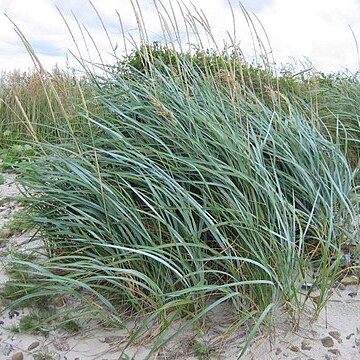Herbs perennial. Plants usually with rhizomes, rarely without. Culms usually erect. Leaf sheath split almost to base; ligule leathery-membranous; auricles lanceolate or crescent-shaped; leaf blade usually glaucous, usually rolled, rarely flat, stiff, harsh. Inflorescence spikelike, linear, rarely oblong-ovate; rachis tough. Spikelets in regular rows of (1 or)2 or 3(–6) per node, sessile, all similar, with (1–)3–7 florets; rachilla disarticulating above glumes and between florets. Glumes opposite or side-by-side, linear to lanceolate, 1–3(–5)-veined, veins not raised (except in L. mollis), not keeled or keeled almost to base, apex acute to shortly awned. Lemma 3–7-veined, abaxially not keeled or keeled only at apex, apex acute to shortly awned; callus obtuse, triangular or rounded. Lodicules lanceolate to ovate, usually entire. Caryopsis adherent to lemma.
Similar to Elymus, and like it with the rachilla twisted and the glumes displaced to stand side by side subtending the spikelets, but outcrossing, with anthers mostly over 3 mm, and with awnless or only shortly awned lemmas; plants tufted or more often on ± elongate rhizomes. 30, N. Hemisphere.

